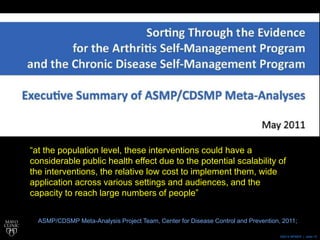Leppin_CDSMP Talk
- 1. ÂĐ2014 MFMER | slide-1 Optimizing Chronic Disease Care in Southeast Minnesota Implementation of the chronic disease self- management program Aaron Leppin, MD Dissemination and Implementation Research Core Knowledge and Evaluation Research Unit; Mayo Clinic
- 2. ÂĐ2014 MFMER | slide-2 Half of all American adults have a chronic disease and prevalence is increasing2 One in four Americans live with multiple chronic conditions2 Chronic diseases account for 80% of all medical care costs in the United States1 Seven out of every ten deaths in the US are the result of chronic disease1 1Kansas Health Institute, 2014; 2Robert Wood Johnson Foundation, 2010;
- 3. ÂĐ2014 MFMER | slide-3 Treatment costs of chronic diseases in Minnesota are estimated at $5 billion annually2 Lost productivity from chronic illness adds $17 billion in costs to Minnesota businesses2 In 2010, chronic diseases accounted for the seven leading causes of death and 57% of potential years of life lost in MN1 In Southeast Minnesota, Community Health and Needs Assessments consistently identify chronic disease management as an area of priority 1Minnesota Center for Health Statistics, 2012; 2Milken Institute, 2007;
- 4. ÂĐ2014 MFMER | slide-4
- 5. ÂĐ2014 MFMER | slide-5 DHHS, AHRQ, and CMS identified four goals: 1. Foster systems change 2. Empower individuals 3. Equip clinicians 4. Enhance research Parekh, JAMA, 2014.
- 6. ÂĐ2014 MFMER | slide-6 The Stanford Chronic Disease Self- Management Program (CDSMP)
- 7. ÂĐ2014 MFMER | slide-7 MIndfulness Dealing with pain Communication strategies Making decisions Problem solving Dealing with emotions Healthy eating Exercising Self-Management Tasks 1. Take care of health condition 2. Carry out normal activities 3. Manage emotional changes1 1Chart 1 from the CDSMP Program Leaderâs Manual, Stanford University, 2012
- 8. ÂĐ2014 MFMER | slide-8
- 9. ÂĐ2014 MFMER | slide-9 âIâve developed a new relationship with my doctors. Iâm not afraid to ask questionsâĶIâm a member of the team.â âThe class helps you live life, not just endure it.â âI am not so isolated.â âMy health happens between visits, outside the hospital and office.â âI learned new strategies for keeping depression and pain at bay, ways to relax my mind and body, and eye-opening ideas for exercise that I could do.â CDSMP Fact Sheet, National Council on Aging
- 10. ÂĐ2014 MFMER | slide-10 Randomized Trial Outcomes 6 months follow-up: exercise, cognitive symptom management, communication with physicians, self-reported health, distress, fatigue, disability, social/role activities, hospitalizations and days in hospital all improve1 2 years follow-up: reduced health care utilization, improved self-efficacy2 1Lorig, Med Care, 1999; 2Lorig, Med Care, 2001;
- 11. ÂĐ2014 MFMER | slide-11 National observational study Replicated findings among 1170 participants in 22 sites across 17 states 1 year follow-up: self-reported health, depression, fatigue, pain, stress, sleep, communication with physician, medication adherence, health literacy, healthcare utilization all improve1 1Ory, Med Care, 2013;
- 12. ÂĐ2014 MFMER | slide-12 National observational study Net savings of $364 per person1 Potential saving of $6.6 billion by reaching 10% of Americans with one or more chronic conditions2 1Ory, Med Care, 2013; 2Ahn, BMC Public Health, 2013
- 13. ÂĐ2014 MFMER | slide-13 ASMP/CDSMP Meta-Analysis Project Team, Center for Disease Control and Prevention, 2011; âat the population level, these interventions could have a considerable public health effect due to the potential scalability of the interventions, the relative low cost to implement them, wide application across various settings and audiences, and the capacity to reach large numbers of peopleâ
- 14. ÂĐ2014 MFMER | slide-14 ASMP/CDSMP Meta-Analysis Project Team, Center for Disease Control and Prevention, 2011; As result of findings, executive summary identified several key strategies to move forward: âĒ Incorporate CDSMP referral into standards of care, care protocols, and other policies that guide high- quality chronic disease care âĒ Invest resources to support wide-scale implementation âĒ Encourage CDSMP participation as part of routine care of individuals with chronic disease âĒ Research: explore differential effectiveness by participant characteristics
- 15. ÂĐ2014 MFMER | slide-15 Why now?
- 16. ÂĐ2014 MFMER | slide-16 Prepared by Health Promotions and Chronic Disease Division and the Office of Statewide Health Improvement Initiatives; MDH, 2012; âNo single organization can accomplish the goals and objectives set forth in this framework. But every organization or entity whose mission entails improving the health of Minnesotans should be able to see itself somewhere in this framework.â
- 17. ÂĐ2014 MFMER | slide-17 Why here? Rice Houston Dodge Mower Fillmore Goodhue Olmsted Winona Wabasha Steele Freeborn Regional infrastructure to support program implementation, oversight, and participation
- 18. ÂĐ2014 MFMER | slide-18 MCHS Site Elder Network Site
- 19. ÂĐ2014 MFMER | slide-19 How has this been done?
- 20. ÂĐ2014 MFMER | slide-20 Current Status/Next Steps âĒ Stakeholders engaged at multiple levels âĒ Finalizing protocol and approach to CBPR project âĒ Evaluating key strategies and funding opportunities
- 21. ÂĐ2014 MFMER | slide-21 Questions & Discussion leppin.aaron@mayo.edu




















